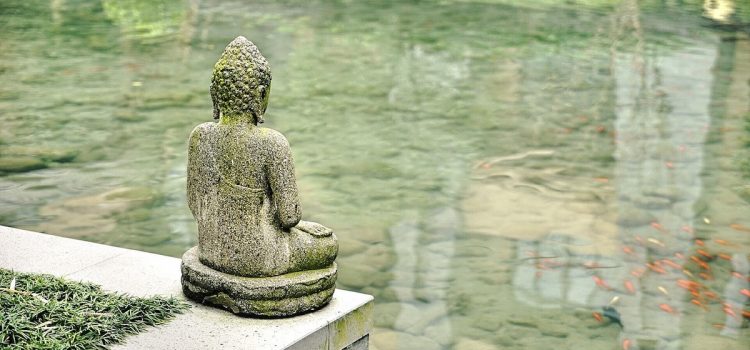

This article is an excerpt from the Shortform book guide to "Waking Up" by Sam Harris. Shortform has the world's best summaries and analyses of books you should be reading.
Like this article? Sign up for a free trial here.
Which Buddhist teachings does secularist Sam Harris follow? Why?
Sam Harris isn’t religious, but he’s spiritual. In his book Waking Up, he discusses how to separate spirituality from the confines of religion, and why, out of all the major faiths, Buddhism provides the most practical roadmap to having spiritual experiences without the baggage of superstition and dogma.
Continue reading to understand why, for Sam Harris, Buddhism has something to offer.
Sam Harris on Buddhism
If we discard any supernatural causes, then the common ground shared by anyone who’s had a spiritual experience is the human condition itself—namely, cognition and emotion. This shared human experience is where we find the universal truths that various opposing religions have uncovered. Most religions hide the path to these truths behind a maze of superstition, ritual, and dogma. But, according to Sam Harris, Buddhism approaches spirituality with an almost scientific focus on experiment and observation. This opens a path for nonbelievers to experience a transformation of consciousness without paying heed to any supernatural claims.
(Shortform note: Harris isn’t alone in noting Buddhism’s applicability outside the realm of religious belief. In Sapiens, Yuval Noah Harari classifies Buddhism as a form of religion based on natural laws rather than the laws of a deity. Harari notes that the particular rules upon which Buddhism is founded are those of psychology—the behavior patterns of the human mind. Harari’s definition of what constitutes a religion is fairly broad, encompassing non-supernatural belief systems such as capitalism, humanism, and some atheist philosophies, like Harris’s.)
To be fair, Buddhism makes supernatural claims just like any other religion, such as the existence of spirits, reincarnation, and that some Buddhist adepts have extranormal powers. Nevertheless, Harris points out that when stripped of its mythological framework, Buddhism has an empirical core—a practical process to bring your awareness into the present moment so that you can realize that your thoughts and emotions don’t define your existence. Instead of asking you to take this idea on faith, Buddhism makes the testable assertion that the more you practice meditation, the more you’ll be able to free yourself from suffering.
(Shortform note: Buddhism’s focus on suffering as a universal human trait has led some to criticize it as a fundamentally pessimistic religion. However, in The Book of Joy, the Dalai Lama and Desmond Tutu both affirm that acceptance of suffering doesn’t entail rejecting happiness. Instead, the opposite is true, because acceptance of suffering leads directly to compassion and creates opportunities for personal growth if you can find meaning in the circumstances that cause you and others pain. From this point of view, suffering isn’t the antithesis of joy—joy is simply what comes afterward.)
The Paradox of Enlightenment
Realizing that your sense of selfhood is just a figment of your imagination brings up the following conundrum: Why should you work to improve yourself if your “self” doesn’t really exist? Harris explains how different schools of thought address this riddle, then explores the teachings of Dzogchen Buddhism and how it points toward a healthy approach to accepting life’s pitfalls while striving to be better. Harris says that meditation doesn’t “make your mind better”—it reveals a state of tranquility that was there for you to access all along.
(Shortform note: That the brain has a built-in capacity for transcendental awareness has been documented by neuroscientist Jill Bolte Taylor, not through meditation or experimentation, but by suffering a stroke on the left side of her brain. In My Stroke of Insight, Taylor recounts that when her stoke shut down her inner monologue and her capacity for linear thought, she ceased to perceive herself as a separate entity from the world around her, but rather as part of a continuum of existence that brought feelings of peace she’d never noticed before. Taylor’s experience revealed to her that a deep sense of peace and connection with the world is hardwired into the human brain and that anyone can learn to engage it.)
However, since the practice of meditation is a skill that must be mastered and improved, there are two different schools of thought regarding the attainment of enlightenment through seemingly meaningless “self” improvement. Here, Harris turns to Buddhism for guidance, for while he disregards Buddhism’s mystical claims, he embraces its “try this and see” approach toward spiritual understanding.
(Shortform note: Harris isn’t the first to comment on the practical, grounded aspects of Buddhism. In The Art of Happiness, the Dalai Lama himself lays out a pragmatic approach to contentment based on education, self-motivation, and doing the mental work of mindfulness, none of which call for a belief in the supernatural. While he recommends making spirituality a part of your daily life, the Dalai Lama explicitly states that it doesn’t matter if your spirituality is religious or secular—what’s important are the positive actions that result from your spiritual life.)
The approach embodied by Theravada Buddhism ignores the paradox of self-improvement entirely by setting enlightenment as a distant future goal that may never be achieved but should always be worked toward. Harris argues that the problem with this approach is that it intellectualizes the concept of the illusion of the self. After all, if you’re thinking about how your sense of selfhood is an illusion, you’re still thinking instead of experiencing pure awareness. Another approach, Advaita Vedānta, asserts that meditation isn’t a path to enlightenment and that a full understanding of the illusion of selfhood can only come as a flash of insight, one that once seen cannot be unseen, almost like an optical illusion.
(Shortform note: Though the other systems of thought that Harris writes about are Buddhist, Advaita Vedānta is a Hindu philosophy dating back to the 9th century CE. A central tenet of Advaita Vedānta is that there’s no distinction between the individual self and Brahman—the underlying reality of the universe. In Advaita Vedānta, the spiritual goal is to realize that the whole world is an illusion, one that you can learn to transcend as you perceive higher truths.)
Harris adopts a personal approach adhering to the teachings of Dzogchen Buddhism, whose ideas lay somewhere in the middle ground. The point of Dzogchen is to break through the illusion of selfhood and experience pure consciousness at any given moment. This breakthrough isn’t a product of drawn-out meditation, but rather takes the form of an instant awareness of the illusion. However, Dzogchen teachers acknowledge that you’re unlikely to have the “flash of insight” you’re trying to achieve without the observational skills developed by practicing meditation. Therefore, in Dzogchen, you meditate to strengthen your awareness so that when your moment of insight comes, you’ll be able to recognize it for what it is.
| A Brief History of Buddhism Siddhartha Gautama, the historical Buddha, was born in what is present-day Nepal in the 6th century BCE, and though he lived in luxury, he’s believed to have achieved enlightenment after witnessing and meditating on the suffering of others. Theravada Buddhism, as practiced in southeast Asia, is believed to be the oldest existing form of the religion. More than other Buddhist sects, Theravada recognizes the historical humanity of the Buddha rather than viewing him as a divine figure. The other major branch of the faith is Mahayana Buddhism, practiced in China, Japan, and Tibet. It dates back to Buddhist monks of the 1st century BCE who viewed the Buddha as a transcendental being and believed that it’s possible for anyone to attain enlightenment. Dzogchen, the path that Harris recommends, is not a separate school of Buddhism but is instead an advanced set of practices within the Tibetan Mahayana tradition. |
Harris says that, by following the teachings of Dzogchen Buddhism, he’s able to see through his own illusion of selfhood. He can’t do it all the time, but with practice, he can access an unclouded awareness of the present moment on a regular basis. He finds that this kind of spiritual awareness doesn’t lead to detachment or a lack of motivation to improve himself. Rather, he argues that such an awareness can help you find a place of calm and clarity from which you can accept your life and the world while striving to make things better.
(Shortform note: Much like the paradox posed at the start of this section, Harris’s assertion that you can accept how things are and still work to improve them may seem like a contradiction. This concept is resolved more fully by Buddhist psychologist Tara Brach in Radical Acceptance. Brach argues that growth through acceptance is a two-part process. The first is to accept your feelings and emotions without judgment so you can let go of the harmful narratives you might have constructed around them. This frees you to take the second step: treating yourself and others with compassion. For Brach, compassion isn’t just a feeling; it’s a positive response that can change your life, just as Harris suggests you can do once you see past your own illusions.)

———End of Preview———
Like what you just read? Read the rest of the world's best book summary and analysis of Sam Harris's "Waking Up" at Shortform.
Here's what you'll find in our full Waking Up summary:
- Why those who reject religion are missing out on something crucial
- A reason-based approach to spirituality that’s rooted in science and meditation
- What science and theology have to say about the soul and the mind






